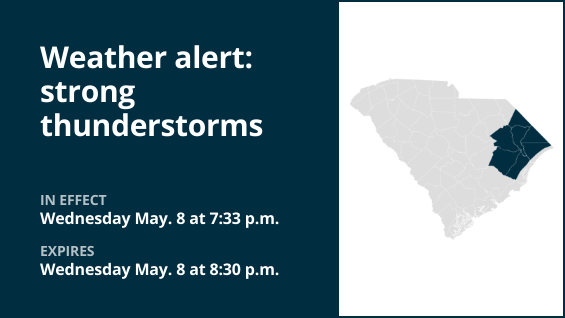An updated report from the National Weather Service was issued on Wednesday at 8:22 p.m. for strong thunderstorms until 9 p.m. for Horry County.
The storms may bring wind gusts of up to 40 mph and pea-sized hail (0.25 inches).
“At 8:20 p.m., Doppler radar tracked a cluster of strong thunderstorms along a line extending from south of Lake Waccamaw to Conway. Movement was east at 40 mph,” says the weather service. “Gusty winds could knock down tree limbs and blow around unsecured objects. Minor hail damage to vegetation is possible.”
Locations impacted by the alert include North Myrtle Beach, Oak Island, Shallotte, Sunset Beach, Holden Beach, Ocean Isle Beach, Little River, Cherry Grove, Boiling Spring Lakes, Calabash and Longwood. This includes the following highways: US Route 17 in Brunswick County between mile markers 1 and 38. SC Highway 31 between mile markers 13 and 24. SC Highway 22 between mile markers 17 and 26.
The weather service states, “If outdoors, consider seeking shelter inside a building.”
This alert is in effect until 9 p.m.

Shielding yourself from approaching lightning: Expert safety guidelines
Each year, lightning strikes the United States approximately 25 million times, with the majority of these electrifying events occurring during the summer months. Unfortunately, lightning is responsible for claiming the lives of approximately 20 people annually, as reported by the weather service. The threat of lightning becomes more pronounced as thunderstorms draw nearer, peaking when the storm is directly overhead and gradually waning as it moves away.
To protect yourself during a thunderstorm, take these recommendations into consideration:
1. Lightning safety plan:When venturing outdoors, it’s vital to establish a clear plan for seeking shelter in case of lightning.
Monitor the sky for threatening signs and listen for the sound of thunder. If thunder is audible, it’s an indication that lightning is nearby.
Seek a safe place to shelter, preferably indoors.
2. Indoors safety measures:Once you’ve found shelter indoors, abstain from using corded phones, electrical appliances, or plumbing fixtures, and refrain from approaching windows and doors.
Lightning can follow conductive pathways, and these precautions reduce the risk of electrical surges.
3. Wait for the all-clear:After the last lightning strike or thunderclap, wait at least 30 minutes before resuming outdoor activities.
It’s important to remember that lightning can strike even when a storm seems to have passed, so exercise caution.
When indoor shelter isn’t available:If you find yourself outdoors with no access to indoor shelter during a thunderstorm, take these steps to maximize your safety:
Avoid open fields, hilltops, or ridge crests, as they expose you to greater lightning risk.
Steer clear of tall, isolated trees and other prominent objects. In wooded areas, stay close to lower stands of trees.
If you’re with a group, ensure individuals are spread out to prevent lightning current from transferring between people.
Camping in an open setting during a thunderstorm is strongly discouraged. If no alternative exists, set up camp in a valley, ravine, or other low-lying areas. Remember that a tent offers no protection against lightning.
Do not approach water bodies, wet objects, or metal items. While water and metal don’t attract lightning, they conduct electricity effectively and can pose significant risks.
In summary, when facing the threat of lightning, vigilance and preparedness are your best allies. By following these guidelines, you can significantly reduce the chances of lightning-related accidents and prioritize your safety.
Mastering wet roads: Safety tips for heavy rainfall
Rain can turn roads into hazards. Stay informed and follow these tips from the weather service to ensure safety during heavy rainfall:
Beware of swollen waterways:During heavy rain, avoid parking or walking near culverts or drainage ditches, where swift-moving water can pose a serious risk.
Maintain safe driving distances:Adhere to the two-second rule for maintaining a safe following distance behind the vehicle in front of you. In heavy rain, allow an additional two seconds of distance to compensate for reduced traction and braking effectiveness.
Reduce speed and drive cautiously:On wet roads, slowing down is paramount. Gradually ease off the accelerator and avoid abrupt braking to prevent skidding.
Choose your lane wisely:Stay toward the middle lanes – water tends to pool in the outside lanes.
Visibility matters:Enhance your visibility in heavy rain by activating your headlights. Be particularly vigilant for vehicles in blind spots, as rain-smeared windows can obscure them.
Watch out for slippery roads:The first half-hour of rain is when roads are slickest due to a mix of rain, grime, and oil. Exercise heightened caution during this period.
Keep a safe distance from large vehicles:Don’t follow large trucks or buses too closely. The spray created by their large tires reduces your vision. Take care when passing them as well; if you must pass, do so quickly and safely.
Mind your windshield wipers:Overloaded wiper blades can hinder visibility. If rain severely limits your sight, pull over and wait for conditions to improve. Seek refuge at rest areas or protected spots.
If the roadside is your only option, pull off as far as possible, preferably past the end of a guard rail, and wait until the storm passes. Keep your headlights on and turn on emergency flashers to alert other drivers of your position.
In the face of heavy rain, these precautions can make a significant difference in ensuring your safety on the road. Remember to stay informed about weather conditions and heed guidance from local authorities for a secure journey.







